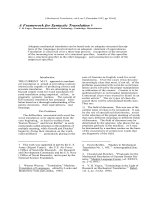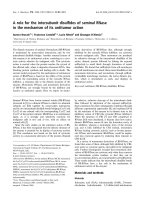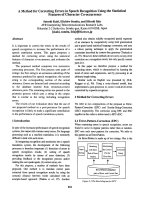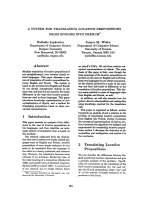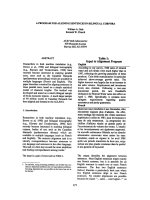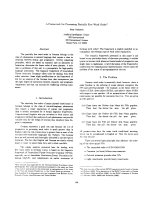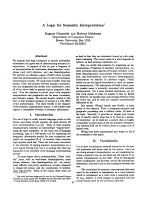Báo cáo khoa học: "A Method for Effective and Scalable Mining of Named Entity Transliterations from Large Comparable Corpora" doc
Bạn đang xem bản rút gọn của tài liệu. Xem và tải ngay bản đầy đủ của tài liệu tại đây (1.11 MB, 9 trang )
Proceedings of the 12th Conference of the European Chapter of the ACL, pages 799–807,
Athens, Greece, 30 March – 3 April 2009.
c
2009 Association for Computational Linguistics
MINT: A Method for Effective and Scalable Mining of
Named Entity Transliterations from Large Comparable Corpora
Raghavendra Udupa K Saravanan A Kumaran Jagadeesh Jagarlamudi
*
Microsoft Research India
Bangalore 560080 INDIA
[raghavu,v-sarak,kumarana,jags}@microsoft.com
Abstract
In this paper, we address the problem of min-
ing transliterations of Named Entities (NEs)
from large comparable corpora. We leverage
the empirical fact that multilingual news ar-
ticles with similar news content are rich in
Named Entity Transliteration Equivalents
(NETEs). Our mining algorithm, MINT, uses
a cross-language document similarity model to
align multilingual news articles and then
mines NETEs from the aligned articles using a
transliteration similarity model. We show that
our approach is highly effective on 6 different
comparable corpora between English and 4
languages from 3 different language families.
Furthermore, it performs substantially better
than a state-of-the-art competitor.
1 Introduction
Named Entities (NEs) play a critical role in many
Natural Language Processing and Information
Retrieval (IR) tasks. In Cross-Language Infor-
mation Retrieval (CLIR) systems, they play an
even more important role as the accuracy of their
transliterations is shown to correlate highly with
the performance of the CLIR systems (Mandl
and Womser-Hacker, 2005, Xu and Weischedel,
2005). Traditional methods for transliterations
have not proven to be very effective in CLIR.
Machine Transliteration systems (AbdulJaleel
and Larkey, 2003; Al-Onaizan and Knight, 2002;
Virga and Khudanpur, 2003) usually produce
incorrect transliterations and translation lexcions
such as hand-crafted or statistical dictionaries are
too static to have good coverage of NEs
1
occur-
ring in the current news events. Hence, there is a
critical need for creating and continually updat-
*
Currently with University of Utah.
1
New NEs are introduced to the vocabulary of a lan-
guage every day. On an average, 260 and 452 new
NEs appeared daily in the XIE and AFE segments of
the LDC English Gigaword corpora respectively.
ing multilingual Named Entity transliteration
lexicons.
The ubiquitous availability of comparable
news corpora in multiple languages suggests a
promising alternative to Machine Transliteration,
namely, the mining of Named Entity Translitera-
tion Equivalents (NETEs) from such corpora.
News stories are typically rich in NEs and there-
fore, comparable news corpora can be expected
to contain NETEs (Klementiev and Roth, 2006;
Tao et al., 2006). The large quantity and the per-
petual availability of news corpora in many of
the world’s languages, make mining of NETEs a
viable alternative to traditional approaches. It is
this opportunity that we address in our work.
In this paper, we detail an effective and scala-
ble mining method, called MINT (MIning
Named-entity Transliteration equivalents), for
mining of NETEs from large comparable corpo-
ra. MINT addresses several challenges in mining
NETEs from large comparable corpora: exhaus-
tiveness (in mining sparse NETEs), computa-
tional efficiency (in scaling on corpora size),
language independence (in being applicable to
many language pairs) and linguistic frugality (in
requiring minimal external linguistic resources).
Our contributions are as follows:
We give empirical evidence for the hypo-
thesis that news articles in different languages
with reasonably similar content are rich sources
of NETEs (Udupa, et al., 2008).
We demonstrate that the above insight can
be translated into an effective approach for min-
ing NETEs from large comparable corpora even
when similar articles are not known a priori.
We demonstrate MINT’s effectiveness on
4 language pairs involving 5 languages (English,
Hindi, Kannada, Russian, and Tamil) from 3 dif-
ferent language families, and its scalability on
corpora of vastly different sizes (2,000 to
200,000 articles).
We show that MINT’s performance is sig-
nificantly better than a state of the art method
(Klementiev and Roth, 2006).
799
We discuss the motivation behind our ap-
proach in Section 2 and present the details in
Section 3. In Section 4, we describe the evalua-
tion process and in Section 5, we present the re-
sults and analysis. We discuss related work in
Section 6.
2 Motivation
MINT is based on the hypothesis that news ar-
ticles in different languages with similar content
contain highly overlapping set of NEs. News
articles are typically rich in NEs as news is about
events involving people, locations, organizations,
etc
2
. It is reasonable to expect that multilingual
news articles reporting the same news event
mention the same NEs in the respective languag-
es. For instance, consider the English and Hindi
news reports from the New York Times and the
BBC on the second oath taking of President Ba-
rack Obama (Figure 1). The articles are not pa-
rallel but discuss the same event. Naturally, they
mention the same NEs (such as Barack Obama,
John Roberts, White House) in the respective
languages, and hence, are rich sources of NETEs.
Our empirical investigation of comparable
corpora confirmed the above insight. A study of
2
News articles from the BBC corpus had, on an
average, 12.9 NEs and new articles from the The
New Indian Express, about 11.8 NEs.
200 pairs of similar news articles published by
The New Indian Express in 2007 in English and
Tamil showed that 87% of the single word NEs
in the English articles had at least one translitera-
tion equivalent in the conjugate Tamil articles.
The MINT method leverages this empirically
backed insight to mine NETEs from such compa-
rable corpora.
However, there are several challenges to the
mining process: firstly, vast majority of the NEs
in comparable corpora are very sparse; our anal-
ysis showed that 80% of the NEs in The New
Indian Express news corpora appear less than 5
times in the entire corpora. Hence, any mining
method that depends mainly on repeated occur-
rences of the NEs in the corpora is likely to miss
vast majority of the NETEs. Secondly, the min-
ing method must restrict the candidate NETEs
that need to be examined for match to a reasona-
bly small number, not only to minimize false
positives but also to be computationally efficient.
Thirdly, the use of linguistic tools and resources
must be kept to a minimum as resources are
available only in a handful of languages. Finally,
it is important to use as little language-specific
knowledge as possible in order to make the min-
ing method applicable across a vast majority of
languages of the world. The MINT method pro-
posed in this paper addresses all the above is-
sues.
800
3 The MINT Mining Method
MINT has two stages. In the first stage, for
every document in the source language side, the
set of documents in the target language side with
similar news content are found using a cross-
language document similarity model. In the
second stage, the NEs in the source language
side are extracted using a Named Entity Recog-
nizer (NER) and, subsequently, for each NE in a
source language document, its transliterations are
mined from the corresponding target language
documents. We present the details of the two
stages of MINT in the remainder of this section.
3.1 Finding Similar Document Pairs
The first stage of MINT method (Figure 2) works
on the documents from the comparable corpora
(C
S
, C
T
) in languages S and T and produces a col-
lection A
S,T
of similar article pairs (D
S
, D
T
). Each
article pair (D
S
, D
T
) in A
S,T
consists of an article
(D
S
) in language S and an article (D
T
) in language
T, that have similar content. The cross-language
similarity between D
S
and D
T
, as measured by the
cross-language similarity model MD, is at least
> 0.
Cross-language Document Similarity Model:
The cross-language document similarity model
measures the degree of similarity between a pair
of documents in source and target languages.
We use the negative KL-divergence between
source and target document probability distribu-
tions as the similarity measure.
Given two documents D
S
, D
T
in source and tar-
get languages respectively, with
TS
VV ,
denoting
the vocabulary of source and target languages,
the similarity between the two documents is giv-
en by the KL-divergence measure, -KL(D
S
|| D
T
),
as:
TT
w
ST
TT
ST
V
Dwp
Dwp
Dwp
)|(
)|(
log)|(
where p(w | D) is the likelihood of word w in D.
As we are interested in target documents which
are similar to a given source document, we can
ignore the numerator as it is independent of the
target document. Finally, expanding p(w
T
| D
s
)
as
)|()|(
S
Vw
TSS
wwpDwp
SS
we specify the
cross-language similarity score as follows:
Cross-language similarity =
)|(log)|()|(
TTST
w w
SS
DwpwwpDwp
T
V
T S
V
S
3.2 Mining NETEs from Document Pairs
The second stage of the MINT method works on
each pair of articles (D
S
, D
T
) in the collection A
S,T
and produces a set P
S,T
of NETEs. Each pair (ε
S
,
ε
T
) in P
S,T
consists of an NE ε
S
in language S, and
a token ε
T
in language T, that are transliteration
equivalents of each other. Furthermore, the
transliteration similarity between ε
S
and ε
T
, as
measured by the transliteration similarity model
MT, is at least β > 0. Figure 3 outlines this algo-
rithm.
Discriminative Transliteration Similarity
Model:
The transliteration similarity model MT measures
the degree of transliteration equivalence between
a source language and a target language term.
Input: Comparable news corpora (C
S
, C
T
) in languages (S,T)
Crosslanguage Document Similarity Model MD for (S, T)
Threshold score α.
Output: Set A
S,T
of pairs of similar articles (D
S
, D
T
) from (C
S
, C
T
).
1 A
S,T
; // Set of Similar articles (D
S
, D
T
)
2 for each article D
S
in C
S
do
3 X
S
; // Set of candidates for D
S
.
4 for each article d
T
in C
T
do
5 score = CrossLanguageDocumentSimilarity(D
S
,d
T
,MD);
6 if (score ≥ α) then X
S
X
S
(d
T
, score) ;
7 end
8 D
T
= BestScoringCandidate(X
S
);
9 if (D
T
≠
) then A
S,T
A
S,T
(D
S
, D
T
) ;
10 end
CrossLanguageSimilarDocumentPairs
Figure 2. Stage 1 of MINT
Input:
Set A
S,T
of similar documents (D
S
, D
T
) in languages
(S,T),
Transliteration Similarity Model MT for (S, T),
Threshold score β.
Output: Set P
S,T
of NETEs (ε
S
, ε
T
) from A
S,T
;
1 P
S,T
;
2 for each pair of articles (D
S
, D
T
) in A
S,T
do
3 for each named entity ε
S
in D
S
do
4 Y
S
; // Set of candidates for ε
S
.
5 for each candidate e
T
in D
T
do
6 score = TransliterationSimilarity(ε
S
, e
T,
MT) ;
7 if (score ≥ β) then Y
S
Y
S
(e
T
, score) ;
8 end
9 ε
T
= BestScoringCandidate(Y
S
) ;
10 if (ε
T
≠ null) then P
S,T
P
S,T
(ε
S
, ε
T
) ;
11 end
12 end
TransliterationEquivalents
Figure 3. Stage 2 of MINT
801
We employ a logistic function as our translitera-
tion similarity model MT, as follows:
TransliterationSimilarity (ε
S
,e
T
,MT) =
),(
TS
1
1
ew
t
e
where
(ε
S
, e
T
) is the feature vector for the pair
(ε
S
, e
T
) and w is the weights vector. Note that the
transliteration similarity takes a value in the
range [0 1]. The weights vector w is learnt dis-
criminatively over a training corpus of known
transliteration equivalents in the given pair of
languages.
Features: The features employed by the model
capture interesting cross-language associations
observed in (ε
S
, e
T
):
All unigrams and bigrams from the
source and target language strings.
Pairs of source string n-grams and target
string n-grams such that difference in the
start positions of the source and target n-
grams is at most 2. Here n
2,1
.
Difference in the lengths of the two
strings.
Generative Transliteration Similarity Model:
We also experimented with an extension of He’s
W-HMM model (He, 2007). The transition prob-
ability depends on both the jump width and the
previous source character as in the W-HMM
model. The emission probability depends on the
current source character and the previous target
character unlike the W-HMM model (Udupa et
al., 2009). Instead of using any single alignment
of characters in the pair (w
S
, w
T
), we marginalize
over all possible alignments:
11
1
11
,|,||
1
jajajj
A
m
j
nm
tstpsaapstP
jj
Here,
j
t
(and resp.
i
s
) denotes the j
th
(and resp.
i
th
) character in w
T
(and resp. w
S
) and
m
aA
1
is
the hidden alignment between w
T
and w
S
where
j
t
is aligned to
j
a
s
,
,m,j 1
. We estimate
the parameters of the model using the EM algo-
rithm. The transliteration similarity score of a
pair (w
S
, w
T
) is log P(w
T
| w
S
) appropriately trans-
formed.
4 Experimental Setup
Our empirical investigation consists of experi-
ments in three data environments, with each en-
vironment providing answer to specific set of
questions, as listed below:
1. Ideal Environment (IDEAL): Given a collec-
tion A
S,T
of oracle-aligned article pairs (D
S
, D
T
)
in S and T, how effective is Stage 2 of MINT in
mining NETE from A
S,T
?
2. Near Ideal Environment (NEAR-IDEAL):
Let A
S,T
be a collection of similar article pairs
(D
S
, D
T
) in S and T. Given comparable corpora
(C
S
, C
T
) consisting of only articles from A
S,T
, but
without the knowledge of pairings between the
articles,
a. How effective is Stage 1 of MINT in re-
covering A
S,T
from (C
S
, C
T
) ?
b. What is the effect of Stage 1 on the
overall effectiveness of MINT?
3. Real Environment (REAL): Given large
comparable corpora (C
S
, C
T
), how effective is
MINT, end-to-end?
The IDEAL environment is indeed ideal for
MINT since every article in the comparable cor-
pora is paired with exactly one similar article in
the other language and the pairing of articles in
the comparable corpora is known in advance.
We want to emphasize here that such corpora are
indeed available in many domains such as tech-
nical documents and interlinked multilingual
Wikipedia articles. In the IDEAL environment,
only Stage 2 of MINT is put to test, as article
alignments are given.
In the NEAR-IDEAL data environment, every
article in the comparable corpora is known to
have exactly one conjugate article in the other
language though the pairing itself is not known
in advance. In such a setting, MINT needs to
discover the article pairing before mining NETEs
and therefore, both stages of MINT are put to
test. The best performance possible in this envi-
ronment should ideally be the same as that of
IDEAL, and any degradation points to the short-
coming of the Stage 1 of MINT. These two en-
vironments quantify the stage-wise performance
of the MINT method.
Finally, in the data environment REAL, we
test MINT on large comparable corpora, where
even the existence of a conjugate article in the
target side for a given article in the source side of
the comparable corpora is not guaranteed, as in
802
any normal large multilingual news corpora. In
this scenario both the stages of MINT are put to
test. This is the toughest, and perhaps the typical
setting in which MINT would be used.
4.1 Comparable Corpora
In our experiments, the source language is Eng-
lish whereas the 4 target languages are from
three different language families (Hindi from the
Indo-Aryan family, Russian from the Slavic fam-
ily, Kannada and Tamil from the Dravidian fami-
ly). Note that none of the five languages use a
common script and hence identification of cog-
nates, spelling variations, suffix transformations,
and other techniques commonly used for closely
related languages that have a common script are
not applicable for mining NETEs. Table 1 sum-
marizes the 6 different comparable corpora that
were used for the empirical investigation; 4 for
the IDEAL and NEAR-IDEAL environments (in
4 language pairs), and 2 for the REAL environ-
ment (in 2 language pairs).
Cor-
pus
Source -
Target
Data
Environ-
ment
Articles (in
Thousands)
Words (in
Millions)
Src
Tgt
Src
Tgt
EK-S
English-
Kannada
IDEAL&
NEAR-IDEAL
2.90
2.90
0.42
0.34
ET-S
English-
Tamil
IDEAL&
NEAR-IDEAL
2.90
2.90
0.42
0.32
ER-S
English-
Russian
IDEAL&
NEAR-IDEAL
2.30
2.30
1.03
0.40
EH-S
English-
Hindi
IDEAL&
NEAR-IDEAL
11.9
11.9
3.77
3.57
EK-L
English-
Kannada
REAL
103.8
111.0
27.5
18.2
ET-L
English-
Tamil
REAL
103.8
144.3
27.5
19.4
Table 1: Comparable Corpora
The corpora can be categorized into two sepa-
rate groups, group S (for Small) consisting of
EK-S, ET-S, ER-S, and EH-S and group L (for
Large) consisting of EK-L and ET-L. Corpora in
group S are relatively small in size, and contain
pairs of articles that have been judged by human
annotators as similar. Corpora in group L are two
orders of magnitude larger in size than those in
group S and contain a large number of articles
that may not have conjugates in the target side.
In addition the pairings are unknown even for the
articles that have conjugates. All comparable
corpora had publication dates, except EH-S,
which is known to have been published over the
same year.
The EK-S, ET-S, EK-L and ET-L corpora are
from The New Indian Express news paper, whe-
reas the EH-S corpora are from Web Dunia and
the ER-S corpora are from BBC/Lenta News
Agency respectively.
4.2 Cross-language Similarity Model
The cross-language document similarity model
requires a bilingual dictionary in the appropriate
language pair. Therefore, we generated statistical
dictionaries for 3 language pairs (from parallel
corpora of the following sizes: 11K sentence
pairs in English-Kannada, 54K in English-Hindi,
and 14K in English-Tamil) using the GIZA++
statistical alignment tool
(Och et al., 2003), with
5 iterations each of IBM Model 1 and HMM.
We did not have access to an English-Russian
parallel corpus and hence could not generate a
dictionary for this language pair. Hence, the
NEAR-IDEAL experiments were not run for the
English-Russian language pair.
Although the coverage of the dictionaries was
low, this turned out to be not a serious issue for
our cross-language document similarity model as
it might have for topic based CLIR (Ballesteros
and Croft, 1998). Unlike CLIR, where the query
is typically smaller in length compared to the
documents, in our case we are dealing with news
articles of comparable size in both source and
target languages.
When many translations were available for a
source word, we considered only the top-4 trans-
lations. Further, we smoothed the document
probability distributions with collection frequen-
cy as described in (Ponte and Croft, 1998).
4.3 Transliteration Similarity Model
The transliteration similarity models for each of
the 4 language pairs were produced by learning
over a training corpus consisting of about 16,000
single word NETEs, in each pair of languages.
The training corpus in English-Hindi, English-
Kannada and English-Tamil were hand-crafted
by professionals, the English-Russian name pairs
were culled from Wikipedia interwiki links and
were cleaned heuristically. Equal number of
negative samples was used for training the mod-
els. To produce the negative samples, we paired
each source language NE with a random non-
matching target language NE. No language spe-
cific features were used and the same feature set
was used in each of the 4 language pairs making
MINT language neutral.
In all the experiments, our source side lan-
guage is English, and the Stanford Named Entity
Recognizer (Finkel et al, 2005) was used to ex-
tract NEs from the source side article. It should
be noted here that while the precision of the NER
803
used was consistently high, its recall was low,
(~40%) especially in the New Indian Express
corpus, perhaps due to the differences in the data
used for training the NER and the data on which
we used it.
4.4 Performance Measures
Our intention is to measure the effectiveness of
MINT by comparing its performance with the
oracular (human annotator) performance. As
transliteration equivalents must exist in the
paired articles to be found by MINT, we focus
only on those NEs that actually have at least one
transliteration equivalent in the conjugate article.
Three performance measures are of interest to
us: the fraction of distinct NEs from source lan-
guage for which we found at least one translitera-
tion in the target side (Recall on distinct NEs),
the fraction of distinct NETEs (Recall on distinct
NETEs) and the Mean Reciprocal Rank (MRR)
of the NETEs mined. Since we are interested in
mining not only the highly frequent but also the
infrequent NETEs, recall metrics measure how
effective our method is in mining NETEs ex-
haustively. The MRR score indicates how effec-
tive our method is in preferring the correct ones
among candidates.
To measure the performance of MINT, we
created a test bed for each of the language pairs.
The test beds are summarized in Table 2.
The test beds consist of pairs of similar ar-
ticles in each of the language pairs. It should be
noted here that as transliteration equivalents must
exist in the paired articles to be found by MINT,
we focus only on those NEs that actually have at
least one transliteration equivalent in the conju-
gate article.
5 Results & Analysis
In this section, we present qualitative and quan-
titative performance of the MINT algorithm, in
mining NETEs from comparable news corpora.
All the results in Sections 5.1 to 5.3 were ob-
tained using the discriminative transliteration
similarity model described in Section 3.2. The
results using the generative transliteration simi-
larity model are discussed in Section 5.4.
5.1 IDEAL Environment
Our first set of experiments investigated the ef-
fectiveness of Stage 2 of MINT, namely the min-
ing of NETEs in an IDEAL environment. As
MINT is provided with paired articles in this ex-
periment, all experiments for this environment
were run on test beds created from group S cor-
pora (Table 2).
Results in the IDEAL Environment:
The recall measures for distinct NEs and distinct
NETEs for the IDEAL environment are reported
in Table 3.
Test
Bed
Recall (%)
Distinct NEs
Distinct NETEs
EK-ST
97.30
95.07
ET-ST
99.11
98.06
EH-ST
98.55
98.66
ER-ST
93.33
85.88
Table 3: Recall of MINT in IDEAL
Note that in the first 3 language pairs MINT was
able to mine a transliteration equivalent for al-
most all the distinct NEs. The performance in
English-Russian pair was relatively worse, per-
haps due to the noisy training data.
In order to compare the effectiveness of
MINT with a state-of-the-art NETE mining ap-
proach, we implemented the time series based
Co-Ranking algorithm based on (Klementiev and
Roth, 2006).
Table 4 shows the MRR results in the IDEAL
environment – both for MINT and the Co-
Ranking baseline: MINT outperformed Co-
Ranking on all the language pairs, despite not
using time series similarity in the mining
process. The high MRRs (@1 and @5) indicate
that in almost all the cases, the top-ranked candi-
date is a correct NETE. Note that Co-Ranking
could not be run on the EH-ST test bed as the
articles did not have a date stamp. Co-Ranking is
crucially dependent on time series and hence re-
quires date stamps for the articles.
Test Bed
Comparable
Corpora
Article
Pairs
Distinct
NEs
Distinct
NETEs
EK-ST
EK-S
200
481
710
ET-ST
ET-S
200
449
672
EH-ST
EH-S
200
347
373
ER-ST
ER-S
100
195
347
Table 2: Test Beds for IDEAL & NEAR-IDEAL
Test
Bed
MRR@1
MRR@5
MINT
CoRanking
MINT
CoRanking
EK-ST
0.94
0.26
0.95
0.29
ET-ST
0.91
0.26
0.94
0.29
EH-ST
0.93
-
0.95
-
ER-ST
0.80
0.38
0.85
0.43
Table 4: MINT & Co-Ranking in IDEAL
804
5.2 NEAR-IDEAL Environment
The second set of experiments investigated the
effectiveness of Stage 1 of MINT on comparable
corpora that are constituted by pairs of similar
articles, where the pairing information between
the articles is with-held. MINT reconstructed the
pairings using the cross-language document si-
milarity model and subsequently mined NETEs.
As in previous experiments, we ran our experi-
ments on test beds described in Section 4.4.
Results in the NEAR-IDEAL Environment:
There are two parts to this set of experiments. In
the first part, we investigated the effectiveness of
the cross-language document similarity model
described in Section 3.1. Since we know the
identity of the conjugate article for every article
in the test bed, and articles can be ranked accord-
ing to the cross-language document similarity
score, we simply computed the MRR for the
documents identified in each of the test beds,
considering only the top-2 results. Further, where
available, we made use of the publication date of
articles to restrict the number of target articles
that are considered in lines 4 and 5 of the MINT
algorithm in Figure 2. Table 5 shows the results
for two date windows – 3 days and 1 year.
Test
Bed
MRR@1
MRR@2
3 days
1 year
3 days
1 year
EK-ST
0.99
0.91
0.99
0.93
ET-ST
0.96
0.83
0.97
0.87
EH-ST
-
0.81
-
0.82
Table 5: MRR of Stage 1 in NEAR-IDEAL
Subsequently, the output of the Stage 1 was giv-
en as the input to the Stage 2 of the MINT me-
thod. In Table 6 we report the MRR @1 and @5
for the second stage, for both time windows (3
days & 1 year).
It is interesting to compare the results of MINT
in NEAR-IDEAL data environment (Table 6)
with MINT’s results in IDEAL environment
(Table 4). The drop in MRR@1 is small: ~2%
for EK-ST and ~3% for ET-ST. For EH-ST the
drop is relatively more (~12%) as may be ex-
pected since the time window (3 days) could not
be applied for this test bed.
5.3 REAL Environment
The third set of experiments investigated the ef-
fectiveness of MINT on large comparable corpo-
ra. We ran the experiments on test beds created
from group L corpora.
Test-beds for the REAL Environment: The
test beds for the REAL environment (Table 7)
consisted of only English articles since we do not
know in advance whether these articles have any
similar articles in the target languages.
Results in the REAL Environment: In real
environment, we examined the top 2 articles of
returned by Stage 1 of MINT, and mined NETEs
from them. We used a date window of 3 in Stage
1. Table 8 summarizes the results for the REAL
environment.
We observe that the performance of MINT is
impressive, considering the fact that the compa-
rable corpora used in the REAL environment is
two orders of magnitude larger than those used in
IDEAL and NEAR-IDEAL environments. This
implies that MINT is able to effectively mine
NETEs whenever the Stage 1 algorithm was able
to find a good conjugate for each of the source
language articles.
5.4 Generative Transliteration Similarity
Model
We employed the extended W-HMM translitera-
tion similarity model in MINT and used it in the
IDEAL data environment. Table 9 shows the
results.
Test
Bed
MRR@1
MRR@5
3 days
1 year
3 days
1 year
EK-ST
0.92
0.87
0.94
0.90
ET-ST
0.88
0.74
0.91
0.78
EH-ST
-
0.82
-
0.87
Table 6: MRR of Stage 2 in NEAR-IDEAL
Test
Bed
Comparable
Corpora
Articles
Distinct
NEs
EK-LT
EK-L
100
306
ET-LT
ET-L
100
228
Table 7: Test Beds for REAL
Test Bed
MRR
@1
@5
EK-LT
0.86
0.88
ET-LT
0.82
0.85
Table 8: MRR of Stage 2 in REAL
Test Bed
MRR
@1
@5
EK-S
0.85
0.86
ET-S
0.81
0.82
EH-S
0.91
0.93
Table 9: MRR of Stage 2 in IDEAL using genera-
tive transliteration similarity model
805

